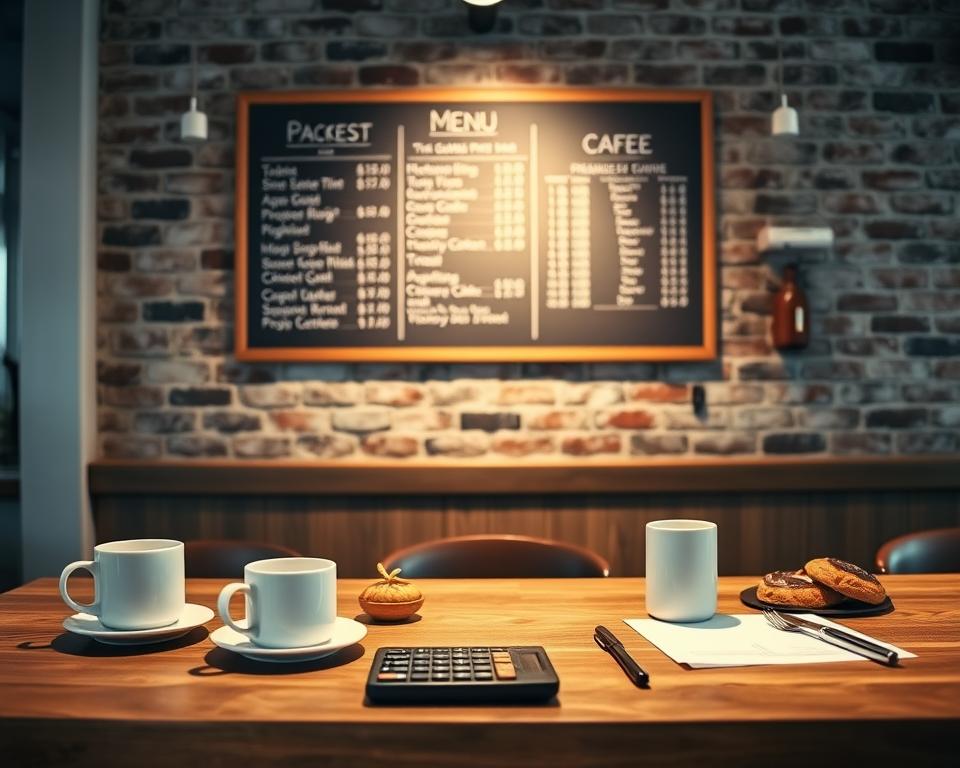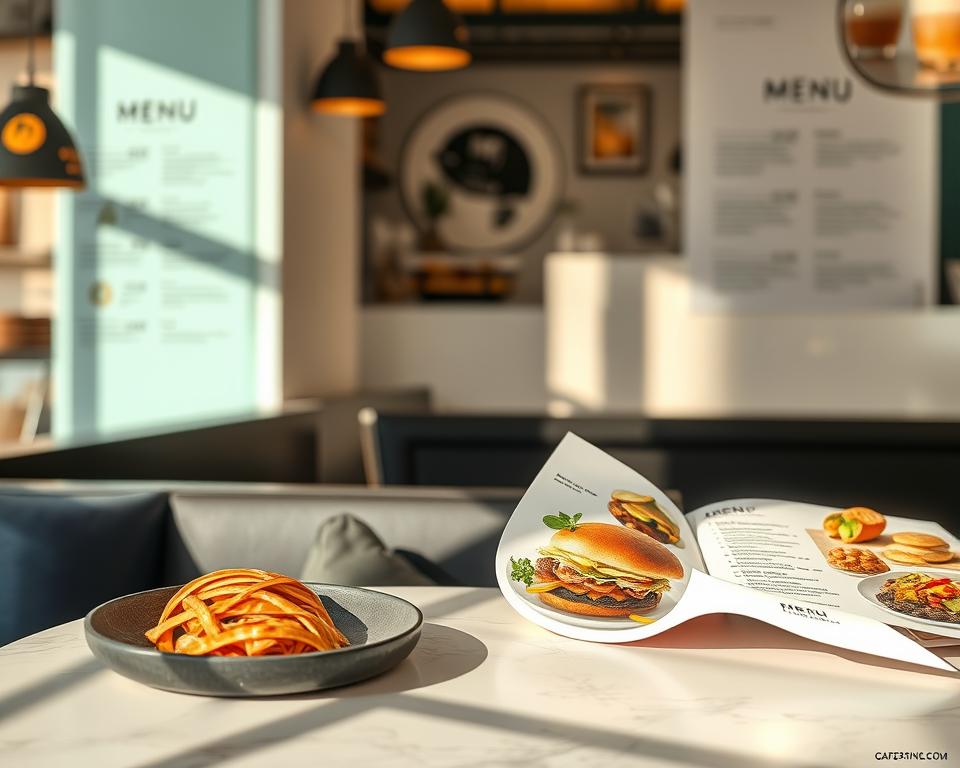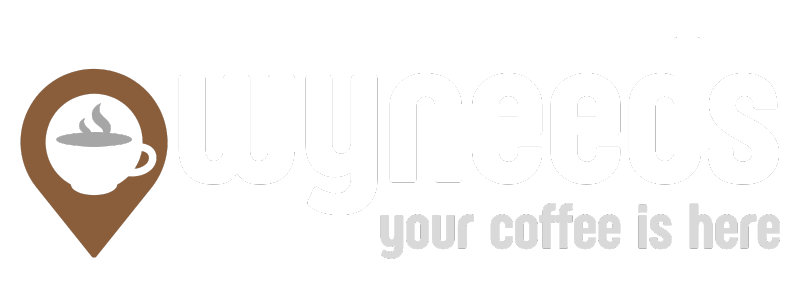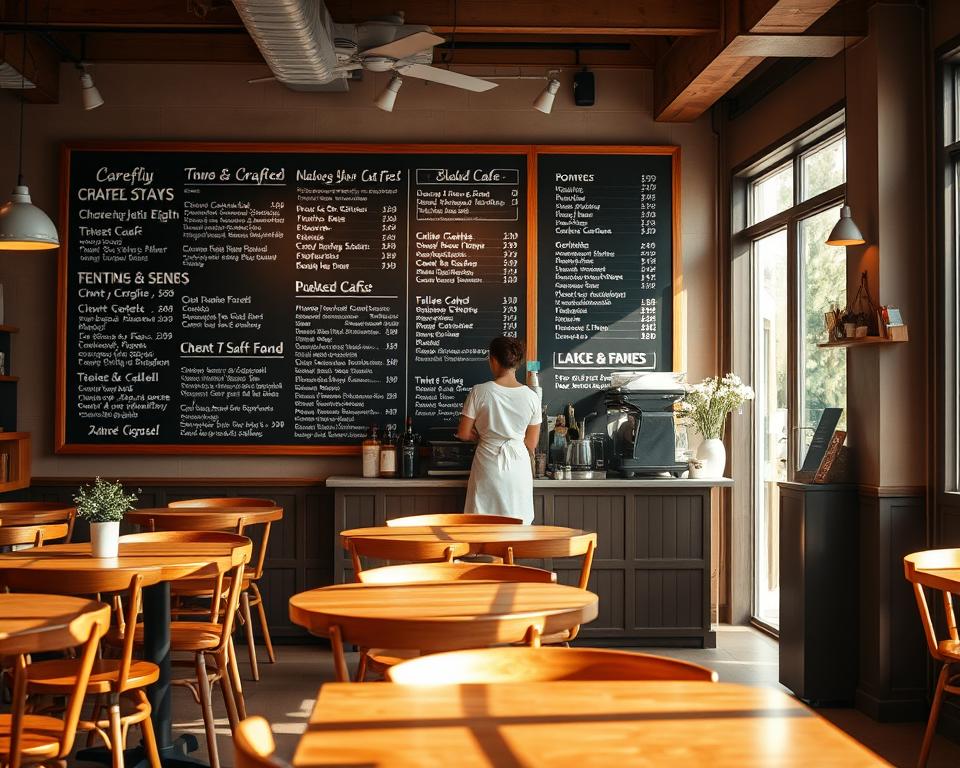Consistent menu engineering can significantly boost a cafe’s bottom line, adding 10% to 15%. It’s a vital strategy in the food and beverage sector. By optimizing menu building and pricing, cafe owners can enhance profitability. Understanding menu optimization and design principles helps create appealing and profitable menus.
Effective menu engineering can increase restaurant profits by 10-15% without affecting foot traffic or food quality. This is achieved through analyzing sales data, customer preferences, and menu item profitability. Cafe menu engineering is a continuous process, requiring ongoing monitoring and reassessment of customer tastes.
Introduction to Cafe Menu Engineering
Menu engineering optimizes menu building and pricing to boost cafe profitability. A well-designed strategy can significantly increase profits and keep the business competitive. Cafe menu engineering, optimization, and design are critical for success in the cafe industry.
Key Takeaways
- Consistent menu engineering can add between 10% to 15% to a cafe’s bottom line
- Effective menu engineering can boost restaurant profits by 10-15% without increasing foot traffic or compromising food quality
- Cafe menu engineering involves optimizing menu building and pricing to increase overall profitability
- Menu engineering is an ongoing process that requires continuous monitoring and reassessment of customer preferences
- Implementing a well-designed menu engineering strategy can increase cafe profits and stay competitive in the market
- Cafe menu engineering, menu optimization, and restaurant menu design are essential components of a successful cafe business
- Analyzing sales data, customer preferences, and menu item profitability is crucial for making informed decisions in cafe menu engineering
Understanding Cafe Menu Engineering Principles
Creating a successful cafe menu goes beyond listing dishes and prices. A well-designed menu can boost revenue by up to 35% and sway customer choices. Cafe owners must grasp the psychology of menu design and its visual appeal. Food menu analysis is key to spotting the most profitable items and placing them wisely.
Menu engineering focuses on limiting each section to about seven items, simplifying customer choices. The “Golden Triangle” areas, like the center and upper-right corners, are prime spots for high-margin items. By using menu engineering strategies, owners can boost menu profitability and improve the customer experience.
Effective strategies include categorizing dishes into “Stars” (high profit and sales), “Opportunities” (high sales but lower profit), “Puzzles” (high profit but low sales), and “Dogs” (low profit and sales). This categorization aids in decision-making and highlights areas for improvement. By analyzing menu item profitability and applying these strategies, owners can craft a balanced, profitable menu that meets customer needs.
Regular menu updates and streamlined choices can speed up customer decision-making, enhancing their experience. By applying these principles and strategies, cafe owners can develop a successful, profitable menu that drives sales and customer satisfaction.
Analyzing Your Cafe’s Target Audience
To craft a winning menu, grasping your target audience is key. You must pinpoint their dietary needs, flavor preferences, and budget limits. Menu optimization is vital to resonate with your audience, ensuring your offerings align with their desires. A thoughtfully designed restaurant menu design can significantly boost customer attraction and retention.
Knowing your audience is critical, as 70% of restaurant failures stem from not understanding their market. Also, 65% of consumers seek restaurants that reflect their values and lifestyle. By implementing menu pricing tactics that resonate with your audience, you can enhance satisfaction and loyalty.
Some crucial statistics to ponder when analyzing your target audience include:
- 58% of diners are swayed by social media when picking a restaurant
- 45% of customers are more likely to return to a place that offers personalized experiences
- 30% of patrons are ready to spend more for unique dining experiences
By integrating these insights into your menu design and pricing, you can craft a menu that captivates your audience. This approach will propel your business towards success.
Crafting a Balanced Menu
To appeal to a wide range of customers and boost profits, menu engineering is key. A balanced menu offers various dishes, catering to different tastes and dietary needs. It’s important to consider profitability and design trends. This approach increases customer satisfaction and encourages repeat visits.
Designing a menu requires focusing on variety and catering to dietary needs. Offering gluten-free, vegan, and vegetarian options, as well as healthy substitutes, attracts a broader customer base. For instance, a cafe can find the best coffee blends to offer a unique and delicious experience.
A balanced menu should have less than 10% low-profit dishes and more than 30% high-profit ones. More than 50% of dishes should be high-profit top-sellers. By adhering to these guidelines and considering design trends, cafes can create a menu that’s both profitable and appealing.
Key considerations for crafting a balanced menu include:
- Offering a range of dishes to cater to different tastes and dietary needs
- Providing healthy substitutes or alternatives for diners
- Considering menu item profitability and menu design trends
- Creating a menu that is easy to navigate and understand
By following these tips and incorporating menu engineering strategies, cafes can create a balanced menu. This drives sales and customer satisfaction.
Using Data to Optimize Menu Items
Optimizing menu items is key to boosting profits and enhancing customer happiness in the foodservice world. By examining sales data, eateries can pinpoint their best sellers and areas needing tweaks. This insight aids in refining menu prices and promoting combo deals to elevate average order values.
In the realm of restaurant menu design, categorizing items into four groups is vital. These groups are Stars, Puzzles, Plowhorses, and Dogs, each with its own sales and profit levels. Stars, being both profitable and popular, are the gems of the menu. Dogs, conversely, are less profitable and less popular, potentially taking up space better used elsewhere.
Effective strategies for menu optimization include:
- Analyzing sales performance data to identify top-selling items and areas for improvement
- Adjusting menu prices and promoting combo deals to increase average order value
- Categorizing menu items into four groups – Stars, Puzzles, Plowhorses, and Dogs – to identify which items are driving the majority of sales and profits
- Using predictive analytics to forecast customer behavior and inform menu engineering decisions
By leveraging data to refine menu items, restaurants can enhance customer satisfaction, increase earnings, and maintain market competitiveness. Effective menu engineering and design are crucial for achieving success in the foodservice sector.
Menu Item Placement Strategies
In menu design, where items are placed is key to influencing what customers buy and boosting profits. A well-thought-out menu can steer a customer’s gaze and enhance their dining experience. Restaurants can use food menu analysis to pinpoint top-selling items and place them where they’re most visible.
Research indicates that guests scan menus for about 109 seconds before deciding. Their gaze follows a pattern, often called the “golden triangle.” This means they first look at the menu’s center, then the top right, and lastly the top left. Placing high-demand items in these spots can significantly increase sales and profits.
Effective menu engineering strategies also involve using visual hierarchies to make the menu clear and attractive. This can be done by employing headings, subheadings, and images to direct the customer’s attention. Restaurants can also employ menu pricing tactics like removing dollar signs and decimals to encourage more spending.
The Eye’s Journey on the Menu
To optimize menu item placement, restaurants should focus on several key factors:
- Limit options per category to around 7 items to reduce anxiety
- Use high-quality photos to increase delivery volume and sales
- Place high-performing items in prominent positions, such as the center and top right of the menu
- Use sensory adjectives in menu descriptions to enhance the guest experience
Leveraging Visual Hierarchies
By leveraging visual hierarchies and effective menu engineering, restaurants can boost profits and create a memorable dining experience. This is achieved through regular menu audits and monitoring sales data. This helps evaluate the impact of changes on item popularity and profitability.
Pricing Strategies for Profit Maximization
To maximize profits in the food and beverage industry, effective pricing strategies are crucial. Understanding menu item profitability is key, as it helps identify high-profit items. By analyzing sales data and customer preferences, operators can optimize their menu design trends to promote profitable items and increase average check size.
A well-designed menu can significantly impact menu optimization and profitability. Operators can use pricing tactics like price anchoring and charm pricing to influence customer purchasing decisions. For instance, offering a premium dish at a higher price point can create a perceived value. At the same time, providing lower-priced options caters to budget-conscious customers. To learn more about effective pricing strategies, visit menu pricing resources.
Regular menu reviews and analysis of customer feedback are essential to adjust prices and optimize profitability. By using data-driven insights and menu optimization techniques, operators can stay ahead of the competition and maintain a profitable business. Some key strategies include:
- Cost-plus pricing to ensure profitability
- Value-based pricing to reflect customer perceived value
- Competitive pricing to stay in line with market rates

By implementing these strategies and continuously monitoring customer preferences and sales data, operators can optimize their pricing and menu design trends to maximize profits and stay competitive in the market.
Designing an Effortless Menu Layout
The layout of a menu is as crucial as the dishes themselves in driving sales and customer satisfaction. A well-designed menu guides customers through the ordering process, emphasizing key items and high-margin dishes. Effective cafe menu engineering and restaurant menu design are key to profitability. By applying food menu analysis principles, restaurants can tailor their menus to meet customer needs and preferences.
Grouping similar items together is a fundamental aspect of menu design. This makes it easier for customers to find what they’re looking for. Categorizing items by course, ingredient, or price point is effective. This approach creates a clear, easy-to-navigate menu that streamlines the ordering process. Highlighting signature dishes with imagery, headings, and descriptive text also draws attention to key items, boosting sales.
Some key considerations for menu layout include:
- Limiting options per category to reduce customer anxiety
- Using high-quality images to showcase dishes and increase appeal
- Strategically placing high-margin items in prime areas of the menu
- Utilizing clear typography and logical organization to enhance readability
By applying these principles, restaurants can craft a menu that is both visually appealing and functional. This drives sales and customer satisfaction. Effective cafe menu engineering and restaurant menu design are vital for profitability, making them essential in any restaurant’s strategy.
The Role of Descriptive Language
Descriptive language is key in menu design, shaping customer choices and boosting profits. Restaurants can make their dishes more enticing by using sensory language and vivid imagery. This is vital in today’s competitive market, where menu engineering strategies are crucial for sales and menu item profitability.
Studies show that descriptive language can increase sales by up to 27%. Customers are drawn to dishes that sound appealing and appetizing. By adopting menu design trends and using attractive keywords, restaurants can enhance their menu’s appeal. For instance, words like “limited-time” can prompt quicker orders by creating a sense of urgency.
Effective strategies for descriptive language in menu design include:
- Employing sensory words, such as “crispy” or “juicy”, to describe dishes
- Adding vivid imagery to make dishes come alive
- Emphasizing high-quality ingredients to justify premium prices
- Using keywords like “locally sourced” or “authentic [city] flavors” to attract customers
By implementing these strategies, restaurants can craft menus that drive sales, enhance profitability, and attract more customers. Given the menu’s importance as a sales tool, it’s crucial to refine it using menu engineering strategies and menu design trends to maximize profits.

Testing and Iterating Your Menu
In the realm of cafe menu engineering, testing and iterating your menu is key to boosting profits and enhancing customer satisfaction. This involves scrutinizing data and feedback to pinpoint areas for enhancement. By leveraging data to guide menu optimization, restaurants can craft a menu that’s both lucrative and customer-friendly.
Menu optimization is a continuous endeavor, necessitating ongoing refinement based on performance metrics and customer insights. Regularly examining sales data and customer feedback allows restaurants to discern which items are hits and which need tweaking. This intel is pivotal in shaping menu design, including pricing and item placement.
Key aspects to consider in menu testing and iteration include:
* Examining sales data to pinpoint best-sellers
* Collecting customer feedback to grasp preferences and challenges
* Utilizing data to steer menu optimization choices
* Continuously refining the menu to keep it relevant and competitive
By adhering to these steps and employing data-driven decision-making in cafe menu engineering, restaurants can forge a menu that fuels sales and customer contentment. Effective restaurant menu design is essential for profit maximization and market competitiveness.
Staying Current with Trends
In the fast-paced world of cafe menus, keeping up with the latest trends is key to boosting profits and pleasing customers. By using local ingredients and adjusting to changing tastes, cafe owners can craft menus that truly reflect their community. These menus also meet the evolving tastes of their audience.
By leveraging menu engineering strategies and menu pricing tactics, astute cafe owners can thrive in the shifting food industry. They can focus on seasonal and local items and stay ahead of the next big food menu analysis trend. This proactive approach can make your cafe stand out and increase profits.
As the industry evolves, staying in tune with consumer behavior and market changes is vital. Regular menu engineering reviews, combined with customer feedback and data-driven insights, help cafe owners make smart choices. These choices keep menus up-to-date, relevant, and in line with what customers want.
FAQ
What is the significance of mastering cafe menu engineering?
How can understanding the psychology behind menu design benefit a cafe?
Why is analyzing the target audience important for cafe menu engineering?
What are the benefits of crafting a balanced menu for a cafe?
How can data analysis optimize menu items for a cafe?
What is the importance of menu item placement in a cafe?
How can pricing strategies impact a cafe’s profitability?
What are the benefits of designing an effortless menu layout for a cafe?
How can descriptive language impact a cafe’s menu?
Why is testing and iterating the menu important for cafes?
How can cafes stay current with trends to improve profitability?

Tina Avila is a writer at WyNeeds, where she delves into the rich and diverse world of coffee. With a passion for flavors and brewing techniques, she brings insightful articles covering everything from coffee culture and bean origins to expert tips on making the perfect cup. Her goal is to inspire and educate coffee enthusiasts, helping them enhance their appreciation for every sip.

